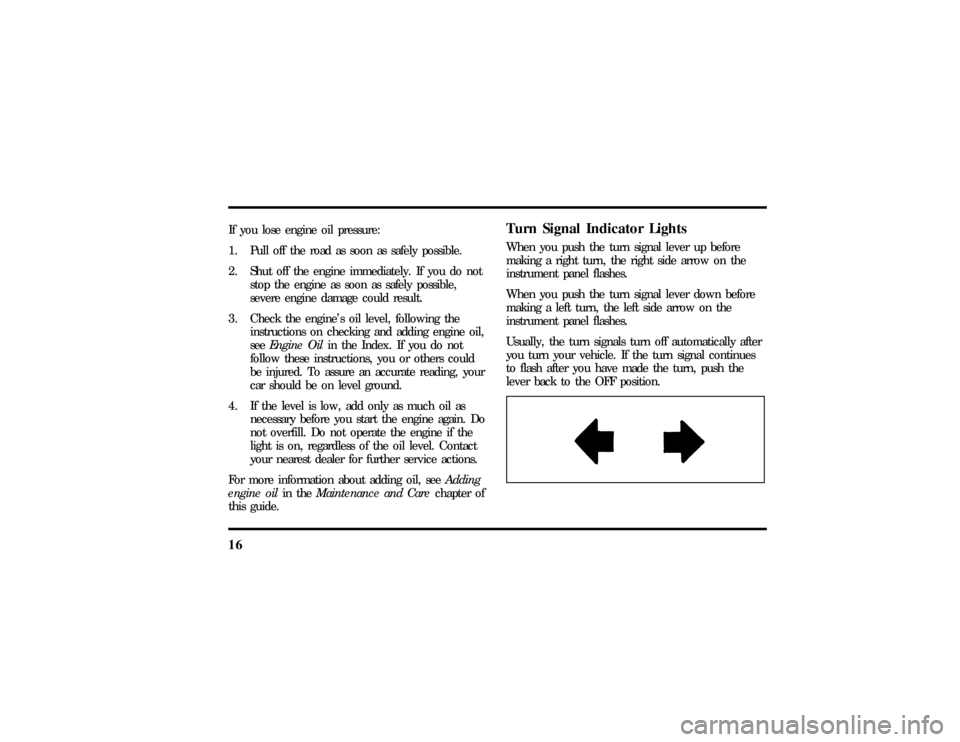Page 20 of 305
15
Charging System Warning LightThis light comes on when you turn your ignition
key from OFF to ON (engine off). The light should
go out when the engine starts and the alternator
begins to charge.
If this light stays on or comes on while your engine
is running, this tells you that your battery is not
being charged and that you need to have the
electrical system checked as soon as possible.
Engine Oil Pressure LightThis light indicates the lack of engine oil pressure,
not the oil level. However, if your engine's oil level
is low, it could affect the oil pressure. The light
should come on every time your ignition key is
turned to ON or START, and should go out when
the engine starts. If the light stays on or turns on
while the engine is running, you have lost oil
pressure and continued operation will cause severe
engine damage.
File:03fnist.ex
Update:Mon Jun 17 13:46:47 1996
Page 21 of 305

16If you lose engine oil pressure:
1. Pull off the road as soon as safely possible.
2. Shut off the engine immediately. If you do not
stop the engine as soon as safely possible,
severe engine damage could result.
3. Check the engine's oil level, following the
instructions on checking and adding engine oil,
seeEngine Oilin the Index. If you do not
follow these instructions, you or others could
be injured. To assure an accurate reading, your
car should be on level ground.
4. If the level is low, add only as much oil as
necessary before you start the engine again. Do
not overfill. Do not operate the engine if the
light is on, regardless of the oil level. Contact
your nearest dealer for further service actions.
For more information about adding oil, seeAdding
engine oilin theMaintenance and Carechapter of
this guide.
Turn Signal Indicator LightsWhen you push the turn signal lever up before
making a right turn, the right side arrow on the
instrument panel flashes.
When you push the turn signal lever down before
making a left turn, the left side arrow on the
instrument panel flashes.
Usually, the turn signals turn off automatically after
you turn your vehicle. If the turn signal continues
to flash after you have made the turn, push the
lever back to the OFF position.
File:03fnist.ex
Update:Mon Jun 17 13:46:47 1996
Page 207 of 305

205
If the acid touches someone's skin, eyes, or
clothing, immediately flush the area with water for
at least 15 minutes. If someone swallows the acid,
have him or her drink lots of milk or water first,
then Milk of Magnesia, a beaten egg, or vegetable
oil. Call a doctor immediately.
To avoid damaging your vehicle or your battery,
and to avoid injury to yourself, follow these
directions for preparing your vehicle to jump-start
and connecting the jumper cables in the order they
are given. If in doubt, call for road service.Preparing Your Vehicle1. Your vehicle has a 12-volt starting system, so
you need to use a 12-volt jumper system. You
will damage your starting motor, ignition
system, and other electrical parts if you connect
them to a 24-volt power supply (either two
12-volt batteries in series or a 24-volt generator
set).2. Do not disconnect the battery of the disabled
vehicle. You could damage the vehicle's
electrical system.
3. Park the booster vehicle close to the hood of
the disabled vehicle.Make sure the vehicles
do not touch each other.Set the parking
brake on both vehicles and stay clear of the
engine cooling fan and other moving parts.
4. Check all battery terminals and remove any
excessive corrosion before you attach the
jumper cables.
5. Turn on the heater fan in both vehicles. Press
the DEFROST button. Turn off all other
switches and gauges.
File:10fnert.ex
Update:Thu Jun 20 15:16:36 1996
Page 221 of 305

219
Checking and Adding Engine OilSince the proper amount of engine oil is important
for safe engine operation, check the oil using the
dipstick each time you put fuel in your vehicle.
Remember the engine must be off, the oil must be
warm and the vehicle must be parked on level
ground.
Checking the engine oil level:
1. Turn the engine off after it has warmed up and
allow a few minutes for the engine oil to drain
back into the oil pan.
2. Set the parking brake, making sure the gearshift
is securely latched in P (Park).
3. Open the hood. Protect yourself from engine
heat.
4. Locate the engine oil dipstick (highlighted in
yellow) and carefully pull it out of the engine.5. Wipe the dipstick clean and put it back into
position, making sure it is fully seated.
Engine oil dipstick
6. Carefully pull the dipstick out again. If the oil
level is below the ªADD 1 QTº line, add
engine oil as necessary. If the oil level is
beyond the letter ªFº in Full, engine damage or
high oil consumption may occur and some oil
must be removed from the engine.
7. Put the dipstick back in and make sure it is
fully seated.
File:11fnmct.ex
Update:Mon Jun 17 13:54:56 1996
Page 247 of 305

245
q
English: MPG = (total miles)/(gallons used).
q
Metric: L/100K = (liters used) x 100/(total
kilometers)
Comparisons With Environmental
Protection Agency (EPA) and Transport
Canada (TC) Fuel Economy EstimatesEPA fuel economy figures are obtained from
laboratory tests under simulated road conditions and
may not reflect the actual conditions you experience
or your style of driving. The EPA fuel economy
estimate is not a guarantee that you will achieve
the fuel economy shown.
The following decrease fuel economy:q
Lack of regular, scheduled maintenance
q
Rapid acceleration and excessive speed
q
Driving with your foot on the brake
q
Sudden stops
q
Extended engine idling
q
Using speed control in hilly terrain
q
Extended use of the A/C, defroster, rear
window defroster and other accessories
q
Underinflated tires
q
Heavy loads
q
Aftermarket add-ons such as bike, ski or luggage
racks, bug deflectors, etc.
Self-Service PointersIf you choose to do your own fueling, you should
also perform a few simple maintenance routines.
This extra effort will save you additional money and
contribute to the driving efficiency of your vehicle.
The following procedures require only a tire gauge,
a rag, an oil can spout and windshield washer fluid.q
Check the engine oil at every refueling stop
q
Clean the windshield, outside mirrors and
headlights
File:11fnmct.ex
Update:Mon Jun 17 13:54:56 1996
Page 261 of 305

260NOTE:Rear axle lube quantities must be replaced
every 100,000 miles (160,000 km) or if the axle
has been submerged in water. Otherwise, the lube
should not be checked or changed unless a leak is
suspected or repair required.Vehicle StorageMaintenance TipsIf you plan on storing your vehicle for an extended
period of time (60 days or more), refer to the
following maintenance recommendations to ensure
your vehicle stays in good operating condition.Generalq
Store all vehicles in a dry, ventilated place.
q
Protect from sunlight, if possible.
q
If vehicles are stored outside, they require
regular maintenance to protect against rust and
damage.
Bodyq
Wash vehicle thoroughly to remove dirt, grease,
oil, tar or mud from exterior surfaces, rear
wheel housing and underside of front fenders.
q
Periodically wash vehicles stored in exposed
locations.
q
Touch-up raw or primed metal to prevent rust.
q
Cover chrome and stainless steel parts with a
thick coat of auto wax to prevent discoloration.
Re-wax as necessary when the vehicle is
washed.
q
Lubricate all hood, door and trunk lid hinges
and latches with a light grade oil.
q
Cover interior soft trim to prevent fading.
q
Keep all rubber parts free from oil and solvents.
File:12fncst.ex
Update:Thu Jun 20 15:16:56 1996
Page 290 of 305

299
Climate control system
air conditioning........... 55
electronic automatic temperature
control.............. 55
heating............... 55
Clock................. 72
Cold engine starting.......... 162
Combination lap and shoulder belts.... 126
Compact disc radio (see Electronic
sound system)............ 35
Controls, mirrors............ 89
Coolant (see Engine coolant)
checking and adding......... 224
preparing for storage......... 261
refill capacities............ 258
specifications............ 259
temperature gauge.......... 10Cooling fan.............. 214
Cupholder(s).............. 73
Customer Assistance Centre,
Ford of Canada............ 270
D
Daytime running light system...... 68
Defects, reporting............ 263
Defrost, windshield........... 63
Dipstick................ 219
automatic transmission fluid...... 230
engine oil.............. 219
power steering fluid......... 229
Disabled vehicle (see Towing)...... 209
Dispute Settlement Board........ 266
Doors................. 96
door ajar warning message....... 31
lubricant specifications........ 259
File:fnixt.ex
Update:Mon Jun 17 13:58:01 1996
Page 292 of 305

301
Engine coolant
checking and adding......... 224
disposal............... 212
preparing for storage......... 261
proper solution........... 212
recovery reservoir.......... 216
refill capacities............ 258
specifications............ 259
temperature gauge.......... 10
Engine coolant temperature gauge
description............. 10
Engine fan............... 214
Engine knocking............ 241
Engine oil
ªbreak-inº oils............. 5
changing oil and oil filter....... 220
checking and adding......... 219
dipstick............... 219
disposal............... 212
engine oil pressure warning light.... 15
filter, specifications.......... 257
refill capacities............ 258specifications.........218, 259
synthetic oil............. 218
viscosity.............. 218
Exhaust fumes............. 165
F
Fan
engine fan, avoiding injury...... 214
Flashers, hazard............ 78
Flashing the lights........... 76
Flat tire................ 192
Fluid refill capacities.......... 258
Ford Dispute Settlement Board...... 266
Ford Motor Company of Canada..... 270
Ford of Canada Customer
Assistance Centre........... 270
Foreign registration........... 272
French owner guides, how to obtain.... 3
File:fnixt.ex
Update:Mon Jun 17 13:58:01 1996